

3D Printing Tracked Vehicles - Making Tracks. Most people would agree that cheap 3D Printers are fun and exciting but there is a commonly held view that they're not really suitable for making useful things.
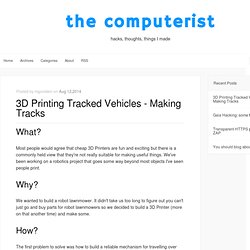
We've been working on a robotics project that goes some way beyond most objects I've seen people print. We wanted to build a robot lawnmower. It didn't take us too long to figure out you can't just go and buy parts for robot lawnmowers so we decided to build a 3D Printer (more on that another time) and make some. The first problem to solve was how to build a reliable mechanism for travelling over rough ground.
Continuous tracks seemed like an obvious solution but track segments, while simple, wouldn't be suitable if they couldn't be made small enough. Most 3D printers introduce contraints that can make intricate designs difficult; especially if you're unwilling to do finishing work on the items you print. 3D Printing an Ironman Helmet. As I mentioned, I had gotten the pepakura helmet file from the RPF forum.
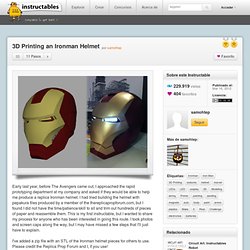
I had also purchased a copy of the Pepakura software. With a full version that allows you to create files rather than just view, I exported the pepakura file as an OBJ which I could would with in Maya. The conversion process was easy, but because the pep file is meant for paper usage, it was relatively low resolution and had no thickness. The first step, while the poly count was low, was to extrude the model inward to give the helmet thickness. Thickness is important, it provides stability to the final product which can be brittle when it is printed too thin. When I was done adjusting the silhouette of the low poly helmet, I subdivided the model to provide a smoother finished surface. 3D Printing on a "really" Uneven Bed. Socket & tip for custom partial finger replacement by IvanOwen. This design is part of the ongoing work of the E-Nable group.
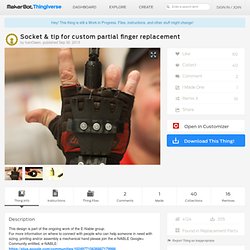
For more information on where to connect with people who can help someone in need with sizing, printing and/or assembly a mechanical hand please join the e-NABLE Google+ Community entitled, e-NABLE: For more information and stories: This is the first in a series of 3 things that, when combined, can be used as a device for some partial finger amputees missing more than half of their finger. It's customizable so that it can be adjusted to the size of the user's hand and fingers. Included in the "files" section is a PDF document with a measurement guide and instructions on assembly.
This thing contains the socket that fits over the finger stump and the artificial finger tip. Cyborg Beast by JorgeZuniga. Second Degree Hand by orgemd. This is a mechanical hand made for users with a functional thumb.
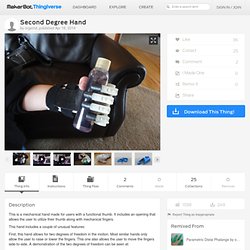
It includes an opening that allows the user to utilize their thumb along with mechanical fingers. This hand includes a couple of unusual features: First, this hand allows for two degrees of freedom in the motion. Most similar hands only allow the user to raise or lower the fingers. This one also allows the user to move the fingers side-to-side.
Second, this hand includes springs on the tuners. This design is also fully parametric OpenSCAD files. InMoov finger prosthetic project by hairygael. Ice and chocolate molds with 3D printing. El tapón por impresión 3D que revoluciona los botes de ketchup. Jonathan Thompson y Tyler Richards, dos emprendedores estudiantes de enseñanza secundaria de Missouri (Estados Unidos), han resuelto gracias a la impresión 3D el molesto problema del líquido acuoso que emana de los botes de ketchup cuando no han sido previamente bien agitados, un fenómeno éste de la separación entre la pasta de tomate y el agua que contiene que técnicamente se denomina 'sinéresis'.
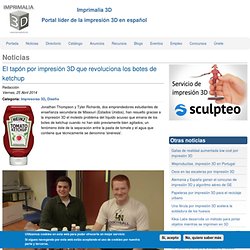
Los dos estudiantes concibieron la idea de imprimir en 3D un tapón que se ve con la forma de un hongo por la parte inferior, para que retuviera el líquido elemento y permitiera únicamente la salida de la pasta de tomate y mediante un chorro perfecto cada vez. Sin embargo, Jonathan y Tyler se acogieron al 'Project Lead the Way Program', una iniciativa del sistema educativo que da a los estudiantes, desde el kindergarten a la escuela secundaria, la oportunidad de aplicar lo que saben: identificar problemas, encontrar soluciones y desarrollar su propio aprendizaje. Pinterest. Dexterity Without Prosperity. Anyone can make DIY furniture with these 3D-printed wood connectors. April 21, 2014 Every year the Milan Furniture Fair heralds a tidal wave of new concepts and products.

This year, Studio Minale-Maeda presented Keystones, a specially-designed connector that holds together various components of a piece of furniture and can be 3D printed at home. These 3D printed plastic connectors combine with standard wooden parts, so that only the essential parts of the furniture need to be shipped, and people could just print the plastic parts on a home 3D printer. The goal is to redefine the design process itself and introduce the active customer participation. Here's some more information from the designers: The work of Studio Minale-Maeda investigates the potentials of multi-directional material translations (digital to analogue to building-block construction), open-source schematics (from Gerrit Rietveld drawings to the online Lego community), and novel forms of distribution (such as downloadable design).